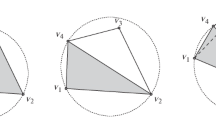Abstract
The essential criterion for stability and fast convergence of CFD-solvers (CFD - computational fluid dynamics) is a good quality of the mesh. Based on results of [30] in this paper we use the so-called centroidal Voronoi tessellation (CVT) not only for mesh generation and optimization. The CVT is applied to develop a new mesh motion method. The CVT provides an optimal distribution of generating points with respect to a cell density function. For a uniform cell density function the CVT results in high-quality isotropic meshes. The non-uniform cases lead to a trade-off between isotropy and fulfilling cell density function constraints. The idea of the proposed approach is to start with the CVT-mesh and apply for each time step of transient simulation the so-called Lloyd’s method in order to correct the mesh as a response to the boundary motion. This leads to the motion of the whole mesh as a reaction to movement. Furthermore, each step of Lloyd’s method provides a further optimization of the underlying mesh, thus the mesh remains close to the CVT-mesh. Experience has shown that it is usually sufficient to apply a few iterations of the Lloyd’s method per time step in order to achieve high-quality meshes during the whole transient simulation. In comparison to previous methods our method provides high-quality and nearly isotropic meshes even for large deformations of computational domains.
Access this chapter
Tax calculation will be finalised at checkout
Purchases are for personal use only
Preview
Unable to display preview. Download preview PDF.
Similar content being viewed by others
References
de Foy, B., Dawes, W.: Unstructured pressure-correction solver based on a consistent discretization of the Poisson equation. International journal for numerical methods in fluids 34, 463–478 (1999)
Farhat, C., Degand, C., Koobus, B., Lesoinne, M.: Torsional springs for twodimensional dynamic unstructured fluid meshes. Computer Methods in Applied Mechanics and Engineering 163(1–4), 231–245 (1998)
Bottassoa, C.L., Detomib, D., Serra, R.: The ball-vertex method: a new simple spring analogy method for unstructured dynamic meshes. Computer Methods in Applied Mechanics and Engineering 194(39–41), 4244–4264 (2005)
Degand, C., Farhat, C.: A three-dimensional torsional spring analogy method for unstructured dynamic meshes. Computers & Structures 80(3–4), 305–316 (2002)
Eymard, R., Herard, J.-M.: Finite Volumes for Complex Applications V. Wiley (2008)
Zeng, D., Ethier, C.R.: A semi-torsional spring analogy model for updating unstructured meshes in 3D moving domains. Finite Elements in Analysis and Design 41(11–12), 1118–1139 (2005)
Wang, D., Qiang, D.: Mesh optimization based on the centroidal voronoi tessellation. International Journal of Numerical Analysis and Modeling 2, 100–113 (2005)
Yan, D.-M., Wang, W., Levy, B., Liu, Y.: Efficient Computation of Clipped Voronoi Diagram for Mesh Generation. Computer-Aided Design 45, 843–852 (2013)
Lien, F.-S.: A pressure-based unstructured grid method for all-speed flows. International journal for numerical methods in fluids 33, 355–375 (1999)
Markou, G.A., Mouroutis, Z.S., Charmpis, D.C., Papadrakakis, M.: The ortho-semi-torsional (OST) spring analogy method for 3D mesh moving boundary problems. Computer Methods in Applied Mechanics and Engineering 196(4–6), 747–765 (2007)
Jasak, H., Tukovic, Z.: Automatic mesh motion for the unstructured finite volume method (November 2006)
Donea, J., Huerta, A., Ponthot, J.Ph., Rodriguez-Ferran, A.: In: Encyclopedia of Computational Mechanics, Chapter 14, Arbitrary Lagrangian-Eulerian Methods (2004)
Chen, L.: Mesh smoothing schemes based on optimal delaunay triangulations. Math Department, The Pennsylvania State University, State College
Ebeida, M.S., Mitchell, S.A.: Uniform random Voronoi meshes. In: Proceedings of the 20th International Meshing Roundtable, Paris, France, pp. 273–290. Sandia National Laboratories, Albuquerque (2011)
OpenFOAM C++ Documentation. http://foam.sourceforge.net/docs/cpp/
Alliez, P., Cohen-Steiner, D., Yvinec, M., Desbrun, M.: Variational Tetrahedral Meshing. ACM Transactions on Graphics. Proceedings of ACM SIGGRAPH 2005 24, 617–625 (2005)
Qiang, D., Wang, D.: Anisotropic centroidal voronoi tessellations and their applications. SIAM Journal on Scientific Computing 26(3), 737–761 (2005)
Qiang, D., Wang, D.: Tetrahedral mesh generation and optimization based on centroidal Voronoi tessellation. International journal for numerical methods in engineering 56, 1355–1373 (2003)
Qiang, D., Emelianenko, M.: Acceleration schemes for computing centroidal Voronoi tessellations. Numerical linear algebra with applications 0, 1–19 (2005)
Qiang, D., Emelianenko, M., Lili, J.: Convergence of the Lloyd algorithm for computing centroidal voronoi tessellations. SIAM Journal Numerical Analysis 44(1), 102–119 (2006)
Qiang, D., Gunzburger, M.D., Lili, J.: Constrained Centroidal Voronoi Tessellations For Surfaces. SIAM Journal on Scientific Computing 24(5), 1488–1506 (2003)
Qiang, D., Faber, V., Gunzburger, M.: Centroidal Voronoi Tessellations: Applications and Algorithms. SIAM REVIEW 41(4), 637–676 (1999)
Löhner, R., Yang, C.: Improved ALE mesh velocities for moving bodies. Communications in Numerical Methods in Engineering 12, 599–608 (1996)
Rycroft, C.H.: Voro++: a three-dimensional Voronoi cell library in C++ (2009)
Jakobsson, S., Amoignon, O.: Mesh deformation using radial basis functions for gradient-based aerodynamic shape optimization. Computers & Fluids 36, 1119–1136 (2007)
Menon, S., Schmidt, D.P.: Conservative interpolation on unstructured polyhedral meshes: An extension of the supermesh approach to cell-centered finite-volume variables. Computer Methods in Applied Mechanics and Engineering 200, 2797–2804 (2011)
Arabi, S., Camarero, R., Guibault, F.: Unstructured meshes for large body motion using mapping operators. Mathematics and computers in simulation 106, 26–43 (2014)
Zhang, X., Zhou, D., Bao, Y.: Mesh motion approach based on spring analogy method for unstructured meshes. Journal of Shanghai Jiaotong University 15, 138–146 (2010)
Zhou, X., Li, S.: A new mesh deformation method based on disk relaxation algorithm with pre-displacement and post-smoothing. Journal of Computational Physics 235, 199–215 (2013)
Wambold, W., Bärwolff, G.: New mesh motion solver for large deformations based on CVT. Procedia Engineering 82, 390–402 (2014)
Author information
Authors and Affiliations
Corresponding author
Editor information
Editors and Affiliations
Rights and permissions
Copyright information
© 2015 Springer International Publishing Switzerland
About this paper
Cite this paper
Wambold, W., Bärwolff, G., Schwandt, H. (2015). Moving Meshes to Fit Large Deformations Based on Centroidal Voronoi Tessellation (CVT). In: Gervasi, O., et al. Computational Science and Its Applications -- ICCSA 2015. ICCSA 2015. Lecture Notes in Computer Science(), vol 9155. Springer, Cham. https://doi.org/10.1007/978-3-319-21404-7_23
Download citation
DOI: https://doi.org/10.1007/978-3-319-21404-7_23
Published:
Publisher Name: Springer, Cham
Print ISBN: 978-3-319-21403-0
Online ISBN: 978-3-319-21404-7
eBook Packages: Computer ScienceComputer Science (R0)




